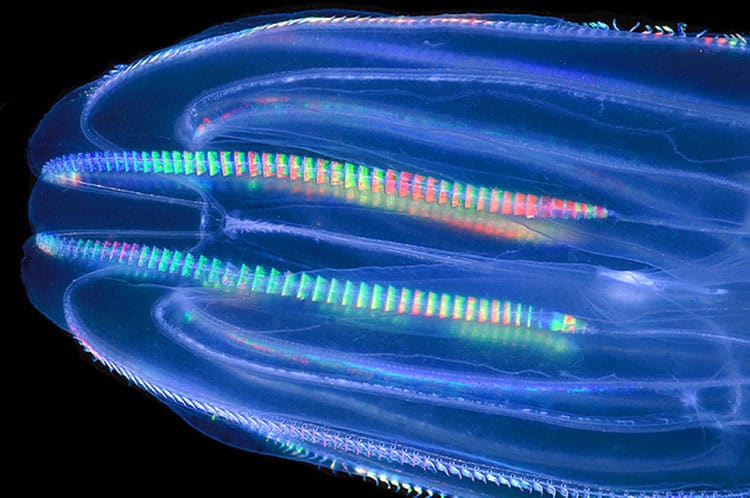by Dr. Sarah Treanor Bois, PhD
Director of Research & Education at the Linda Loring Nature Foundation
August is often described as the “Dog Days of Summer” for multiple reasons. Especially this summer with its endless string of hot days (especially hot for the island) coupled with a drought and record numbers of people. Looking for the positives, there are a lot of amazing things about the second half of August as well. The water is at its peak warmth for swimming, crowds begin to thin, peak wildflower season is starting, and the beach plums are close to ripe.
One of my favorite August pastimes is night swimming in the bioluminescence. If you’ve never had the pleasure before, I’ll do my best to describe the experience before getting into the biology of it. There is something truly magical about cooling down in the shallows of the north shore at night and being greeted by the glowing swirls in the water. It’s like a welcoming glow that helps melt all the stress of summer away. If you take a moment to float and look up, you might be treated to the best light show of the year (sorry to the amazing drone show at this year’s Pops Concert). The twinkling lights of the summer sky matched below by the swirling glow of the bioluminescence—it’s a dreamy experience. It’s a pause, if you will, holding summer in place for a moment between the “Dog Days” and the crisp air of fall.
This week is the perfect time to try it out. With the new moon on August 27, the dark skies coupled with the luminescent sea should be fantastic!
So, what is this glowing stuff anyway? The blueish iridescent glow is actually bioluminescence. Bioluminescence is sometimes referred to as phosphorescence, but the two are not the same. Phosphorescent organisms absorb light from the sun and later give it back. Luminescent organisms, on the other hand, actually produce light through a chemical reaction. The bays of Vieques in Puerto Rico are famous for their light shows, as are beaches in southern California and Toyama Bay in Japan, where “firefly squid” can line the shoreline. But bioluminescent plankton also live in Nantucket waters and can shine nearly as brightly.
The most common bioluminescent plankton in local waters are from the family of single-celled organisms known as dinoflagellates, and they light up due to a similar, but not identical, chemical process as fireflies. In our area, the two most typical sources of underwater pyrotechnics are comb jellies and dinoflagellates. If you see flickering underwater sparkles at a northern beach like Steps Beach, you are likely looking at a type of dinoflagellate known as “sea sparkles.” Sea sparkle (Noctiluca scintillans) is a single-celled dinoflagellate that is heterotrophic; they eat algae and even small zooplankton. For a single- celled organism, the sea sparkle is enormous, up to one millimeter in size.
The comb jellies are a little more common, though, and they come in for a few weeks each summer in response to warming water temps. Our most common species along Nantucket shores is Leidy’s comb jelly also known as the sea walnut. The comb jelly is not a jellyfish at all, but actually a member of the Ctenophora phylum. They are primarily made of water and don’t have stinging cells, so there’s no worry about swimming with these glowing comb jellies.
Boaters describe steaming into the harbor after sunset and their wake being aglow. A naturalist friend says that, besides swimming, night kayaking in Polpis harbor has a certain magic to it during the bioluminescence. Each stroke of the paddle creates a glowing swirl. Be careful paddling at night though!
The comb jellies usually start to come around in July, but the peak of the bioluminescent show is generally in August and around the new moon. Once there is a big night, expect the rest to be waning, but still good. I’m thinking that this week will be the best, so let us know if you head out!
For the best locations, harborside is ideal, but any north shore beach should do. Find a good stretch of shallow, even shoreline on a warm night. You don’t even have to fully swim. Walk along calf- to kneedeep in the water stirring up the jellies and watch them turn on and turn off.
I was first introduced to the light show by my fellow interns at the Maria Mitchell Association in the 1990s. We’d ride our bikes late at night to Steps Beach and try to count shooting stars while floating in the ocean. This tradition continued when I worked in the restaurant industry. There’s nothing quite like a swim after a dinner shift during a Nantucket summer to wash away the August. Couple that refreshment with the luminescence and it’s pure summer magic! You just have to free your mind of other sea creatures and avoid spider crabs. No matter how old or young you are, night swimming with friends usually ends in lots of laughter and splashing. In this way, night swimming in the bioluminescence is also a youth tonic.
And remember, September arrives next week.



